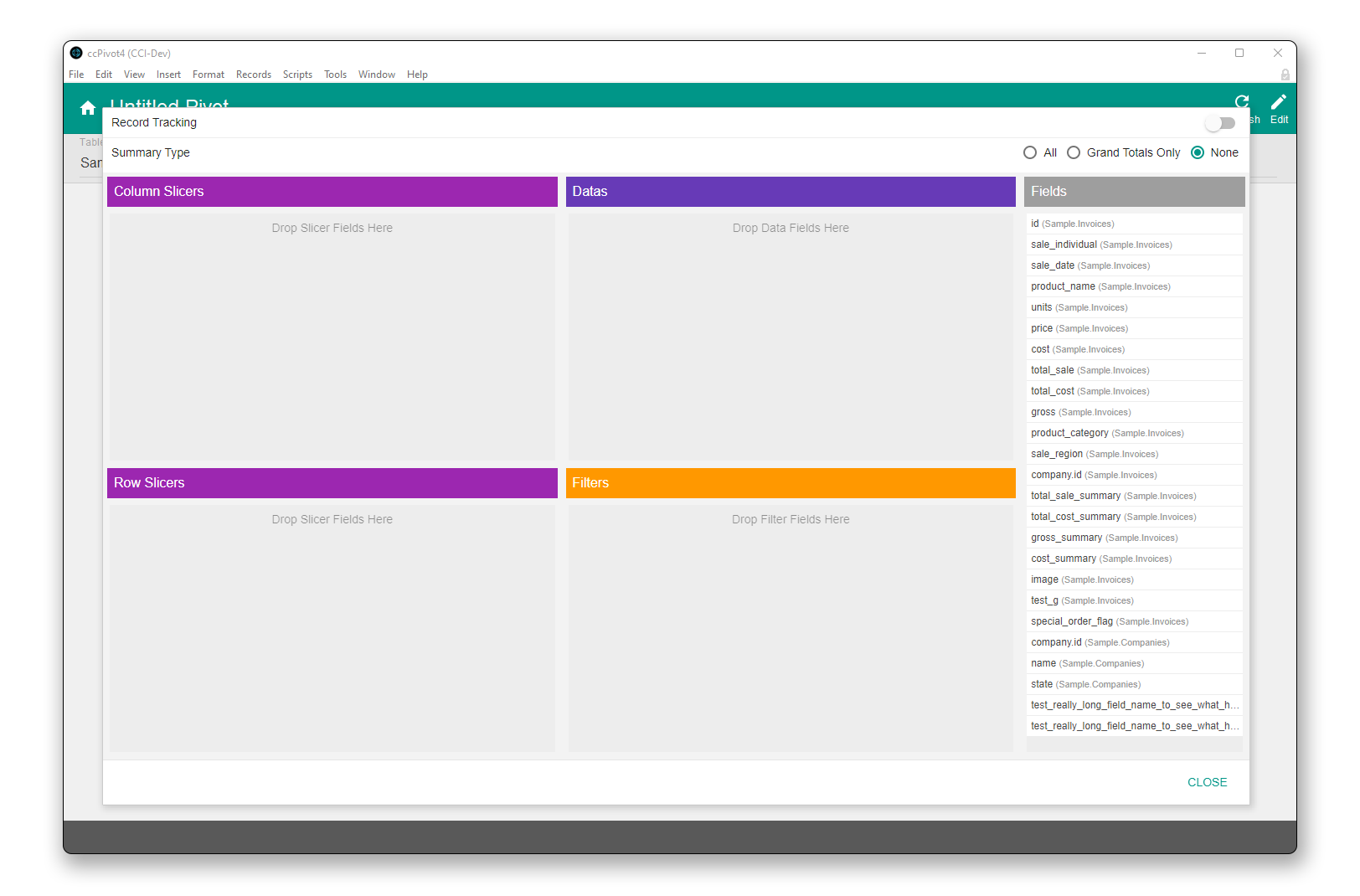To create a report, after clicking ‘+ New’, you will need to select your table, view, and CSS style. This will create a blank report. Add information by clicking the ‘Edit’ button and dragging your Row, Column, Data and Filter fields into place and clicking refresh. Similarly, editing a report is accomplished by selecting the report to edit and clicking the edit button.

¶ Explaining the Options when Creating a Pivot in CCPivot3
There are three main settings on the main edit screen, all of which need to be set to build a report.
¶ Table
This is a simple pop-up menu with all the table occurrences you have integrated in the system. Selecting your data table is an important and necessary step as that will determine the context for the rest of the pivot table.
If you do not see the table occurrence you are looking for in this list, you may need to refresh ccPivot or add your data sources. See the ‘Integration’ page for further explanation.
¶ View
This menu will let you choose to display your report data as a pivot table, or to use one of the interactive charts built in. Whatever option you choose, the data is the same, but will be represented in different ways.
It is important to note that since many of the charts are simpler in their display style than a table can be, your data may look other than you expect in some charts. Pie charts for example are not good for displaying many different data points. You should also note that record tracking is not supported in anything but a table view.
¶ Style
This menu will determine the style of your pivot table. There are a couple things to note, however. First, unlike in the first versions of ccPivot you will have to refresh the pivot to see the effect of changing the style. This was done to improve speed. Second, the styles that are included by default are only meant as a starting point. You as a developer have the power to add as many styles as you want. This is done on the CSS & Javascript tab of the settings screens. The styles are simple cascading style sheets (CSS) and if you are unfamiliar with this form of formatting, there are many fantastic resources online to learn more.
¶ Further Detail in the Edit Screen
Clicking the edit button will pull up the overlay to edit the detail of your report.
¶ Record Tracking
Record tracking allows you to click on a cell in the pivot table and go to a layout with the records that make up the found set determining the content of that cell. This feature requires that an ID field and layout be set for the table the pivot table is based on in the setting screen.
Record tracking is only supported in table view.
¶ Summary Type
A set of radio buttons to let you indicate the type of summary section you want. You can select to either include only the grand total all sub summaries or no summaries at all.
¶ Field Placement Area
The area below the Summary Type selection is where you can drag and drop fields into either the row, column, data and filter sections. Drag and drop from the available fields as well as between areas are supported. You can also drag to reorder the fields. Field order affects the order of operation in each are and can have huge impact on the way your report turns out.
Each of the 5 areas are discussed below in further detail. One thing to note for all 4 areas where you can place fields. Once a field is placed in the appropriate area, you can click it to edit the specifics of it's assignment or drag it out to the available fields are to remove it from it's assigned area.
¶ Column and Row Slicers
For both the column and row slicers, you can drag any field from the available field area into this section to place that field as a group of data to report on. Once a field is placed in this section, it is available for detail editing. You can click to reorder fields here or click the trash can to remove a field from here as well.
Clicking the field will bring up the detail for editing. In the detail screen you can change the name displayed, the sort order and any custom formatting you desire. You can also set any mandatory data points in this screen. This will allow you to define in advance what data points should be available. Months of the year, days of the week or sales staff members for example. Sometimes it is important to have a blank column or row to show that data is missing.
¶ Datas
For the data fields, placing a field in here will select is as one of the fields you actually aggregate for reporting. You can drag fields in here to place them or drag to reorder them. Clicking on a field in here will bring up the editing screen for the data field
Clicking the field will bring up the detail for editing. In the detail screen you can change the name displayed, the sort order and any custom formatting you desire.
¶ Filters
For the filter fields, placing a field in here will select is as one of the fields you want to use as a filter for your data. You can drag fields in here to place them or drag to reorder them. Clicking on a field in here will bring up the editing screen for the data field
Clicking the field will bring up the detail for editing. In the detail screen you can change the name displayed, the sort order and any custom formatting you desire.